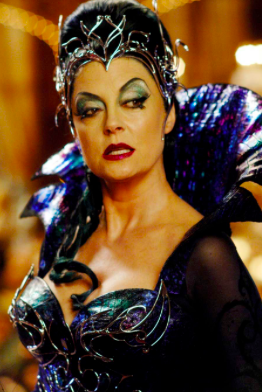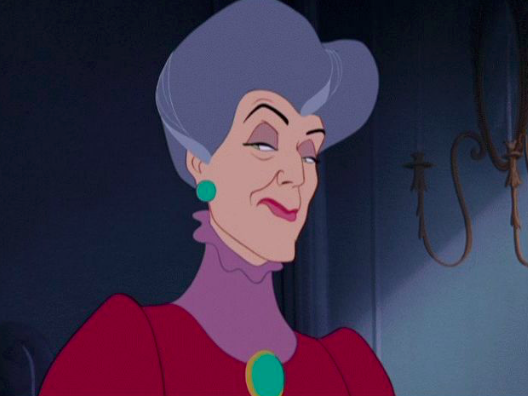Participants of my ongoing Saving Cinderella class have the option to a write guest post on the topic of the session they attended. This post is in response to Session 1: The Importance of Fairy Tales and Why Feminists Get Them So Wrong.
To enroll in a future session of the class, click here.
The following was written by Eric M. Blake.
In discussing the many tropes common to the Disney Princess mythos, one that’s arguably intrigued me the longest is the Wicked Stepmother.
Naturally, I’ve always noticed the villain of Cinderella is “the Wicked Stepmother”—frankly, that’s what everyone calls her on instinct, sooner than “Lady Tremaine.” But then for the first time—courtesy of a Walt Disney World ride—I paid attention to the opening text of Snow White & The Seven Dwarfs.
Lo and behold, the Evil Queen’s specifically identified as Snow White’s stepmother.
In Enchanted—my favorite Disney Princess (“D.P.”) film of all—Queen Narissa is Prince Edward’s stepmother. The trope itself is even discussed by Princess Giselle and the little girl named Morgan—as Morgan, one way or another, will soon have a stepmother in her life. And while both potential stepmothers for her are good, noble, and pure, these stepmothers are in the “real” world; in Andalasia the trope’s played completely straight (courtesy, again, of Narissa).

So what do we make of this? What do these tales have against stepmothers?
Well, nothing, in the “real” world—as Enchanted makes clear. But again, Narissa’s the typical fairy-tale-world stepmother. As can be assumed of any of these tropes, the Wicked Stepmother must therefore be symbolic of something.
Symbolic of what, then?
Well, consider this question: Why a step-mother, not a “birth” mother?
On that note, the two questions are: “What do step mothers and birth mothers have in common?” and “What makes them different?”
Now, what they have in common is the sense of a higher authority over the D.P.—an authority (as Faith Moore points out in Saving Cinderella) that she is obligated to follow until she herself reaches full womanhood. Inherent in this notion, if said authority is understood to be villainous, is a central emotional conflict for the D.P.: She is obligated to, in essence, live in fear of a malevolent higher authority, with no options except to — solely in the case of fear for her life — run away from civilization.

With that out of the way, why, again, a step-mother? (That is: What is the pertinent, symbolic difference between stepmothers and birth mothers?)
Well, I suspect there are two issues at play.
First, there’s an inherent sense of emotional distance, and separation, between a child and stepparent, as opposed to a birth parent. This is arguably essential for the story to remain suitable for enjoyment, without crossing the thematic threshold into the horrifying scenario of a mother mistreating a child she carried and bore, and gave birth to. Such a scenario arguably requires toning down. Having a (comparative) stranger as the villain (making her villainy more “understandable”), who nonetheless has inherent authority, fulfills all story obligations.
Second, something being “wrong” in the D.P.’s situation from the very beginning immediately sets up an initial conflict—in this case, the fact that her birth mother is dead. For Snow White, we might as well assume that her father is, too—after having married the (then-secretly-) Wicked Stepmother, which therefore indicates that the mother died first.

In the case of Cinderella, the opening narration spells out that the kind father felt that Cinderella needed a mother’s care, “And so he married again.” Lo and behold, upon the father’s death, “the stepmother’s true nature was revealed.”
The inherent tragedy of a mother’s death at a young age, followed by the father’s, leaving the girl in the custody of someone “alien” to her natural state, immediately evokes Pity—and the fact that the custodian, the Stepmother, is revealed to be Wicked, evokes Fear. Pity & Fear, as Aristotle laid out in the Poetics, are key emotions for great Tragedy (Drama)…prior to any recovery, and “happily ever after”.
 ERIC M. BLAKE is the chief Culture & Entertainment writer at Western Free Press. A graduate of the University of South Florida, with a Bachelor’s in Political Science and a Master’s in Film Studies, he is very passionate about political theory and filmmaking–and the connections between the two. Inspired by Andrew Breitbart’s axiom that “Politics is downstream from culture,” he is deeply fascinated by the great influence that popular culture has on public opinion, and is a firm believer in the power of storytelling.
ERIC M. BLAKE is the chief Culture & Entertainment writer at Western Free Press. A graduate of the University of South Florida, with a Bachelor’s in Political Science and a Master’s in Film Studies, he is very passionate about political theory and filmmaking–and the connections between the two. Inspired by Andrew Breitbart’s axiom that “Politics is downstream from culture,” he is deeply fascinated by the great influence that popular culture has on public opinion, and is a firm believer in the power of storytelling.
You can also.find him on Twitter, @HardBoiledFilms, and on YouTube, at Hard Boiled Entertainment. Yes, that implies certain cinematic aspirations.
https://westernfreepress.com/time-greatest-conservative-films-introduction-rules/
https://westernfreepress.com/the-culture-current-goals-for-the-right-in-the-culture-war/
https://westernfreepress.com/greatest-conservative-films-enchanted-2007/
First, there’s an inherent sense of emotional distance, and separation, between a child and stepparent, as opposed to a birth parent.
Yes, but along with that emotional distance is the non-recognition of the future princess’s actual identity. The princess story is all about the eventual recognition of the inherent princess qualities of the protagonist. A natural mother would see princess qualities in her own offspring even if they don’t have them. The wicked step mother, for example loves her own children and therefore sees them as future princesses, even though they are highly flawed. Similarly Cinderella’s own mother would also recognize her own daughter’s identity as a Princess. So a stepmother is required in a story about how the hidden “princess” qualities are finally recognized under her rags and servant’s status.
LikeLiked by 1 person
So, to put it another way, the wicked stepmother archetype essentially represents Alaskan Field Mice’s treatment of any litter other than their own to use a Metal Gear Solid reference?
LikeLike
Brilliant! Never thought of that.
LikeLike
Or, one might argue, that the stepmother is not symbolic at all, but rather a very relevant issue in the lives of the peasant folk who originally told these stories. Consider that second marriages were very common, especially for men, because childbirth and illness were often fatal. Therefore, it makes sense that stepmothers featured regularly in the stories told by people of that time. Why were they usually ‘wicked’? Well, because a stepmother would naturally favor her own child/children. A stepchild was a very real threat to their prospects. Child neglect and abuse was also not an uncommon theme in folk tales, mainly because it happened in their everyday lives due to lack of resources. It’s just simple history. If you want biological parents who were just as bad, look at Hansel & Gretel (Grimm’s version).
Point being: it’s not always wise to psychoanalyze EVERY single detail of a fairy tale.
Sorry for playing the devil’s advocate here, but it makes sense in this case. And I know, that’s just my opinion. 🙂
LikeLiked by 1 person
I have studied Korean literature and interestingly also here is present the trope of the evil stepmother, which is used as a means to evoke sympathy for the main character and it seems that the purpose of the story is to overcome this “obstacle” by having this figure punished at the end. An example of that is thw famous story “Hong gil dong”
LikeLiked by 1 person
One scenario that I don’t see played out in the stepparent-stepchild relationship in fairy tales is where the stepchild rejects the stepparent.
LikeLike